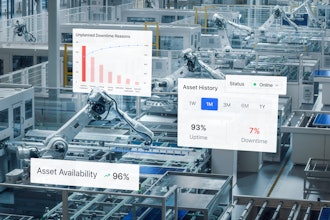When it comes to industrial flooring surfaces, there are many vendors out there who will insist their solution is best. One thing they can all agree on, however, is that an industrial floor is not often just a “set it and forget it” investment, and that maintenance and usage considerations should be at the forefront of any decision.
Surface Prep
Kelly Mortensen, President of Flooring Adventures – the manufacturer of Tuff-Seal interlocking floor tiles – stresses the numerous flooring considerations involved for industrial sites, including how the floors are being utilized, what type of manufacturing is being done, and the condition of the existing floor.
According to Mortensen, approximately 80 to 85 percent of industrial flooring is concrete with an epoxy coating. When it comes to these floors, it’s important for manufacturers to determine which types of equipment they need to prepare their floors for new coatings.
“The surface prep plays a major role,” says Kevin Hill, Outside Sales Rep for Niagara Machine. Erie-based Niagara specializes in the sales and rental of concrete resurfacing and surface prep equipment, and the company feels strongly that the better the prep on the floor, the longer the coating is going to last.
When dealing with concrete, a shot blaster is a pretty one dimensional piece of equipment, according to Mike Trotta of Niagara Machine. This will prep for a medium to high-build epoxy coating. For more diverse needs, a concrete grinder can prep for a thin film coating, or can be used to polish the floor or even remove glue. “I think they both can produce a very quality and durable floor treatment; it just depends on what they’re looking for.”
But whether these coatings will work has a lot to do with the substrate and its condition. “Moisture is the number one cause of flooring failures,” Mortensen explains. “There may not be a vapor retarder under that concrete, so there could be moisture vapor emission problems. Anything you put down on that subfloor could fail. That’s the number one concern.” In addition, says Mortensen, contaminants like grease and oil can result in a floor surface resistant to bond covering. “Always bring in a qualified flooring contractor to take a look at it to ensure proper testing is conducted on the concrete, and they can address any contaminants.”
From Mortensen’s perspective, having concrete that’s contaminated or contending with a moisture problem does not mean the facility must completely tear up the floor. His company’s Tuff-Seal tile is designed to offer a solution for manufacturers who either can’t service their existing floors or don’t want to deal with the downtime related to applying a new epoxy coating. The tiles are loose laid to overlap and be tapped together to interlock. These tiles are not affected by contaminants in an existing floor and serve as a relatively quick fix based on their short installation time. “You could lay the tile and drive over it with a forklift right away,” says Mortensen.
But for those with serviceable concrete, epoxy coatings offer a cost-effective way to keep the floor in good shape: large areas can be surfaced very quickly, almost like “painting” a floor. According to Trotta, some of Niagara Machine’s customers are finding that the ability for them to do this work themselves – in phases – has resulted in a solution that works best. In these cases, customers can rent grinders for this incremental surface prep and don’t have to worry about laying out all the money at once.
Materials Considerations
The decision to refresh, resurface, or upgrade a floor also comes down to the most basic step of understanding which materials work best for the environment, and keep the company’s long term goals in mind – whether those are low maintenance requirements, environmentally friendly composition and cleaning options, or basic ruggedness or durability needs.
Omaha-based L&M has developed and introduced a number of environmentally sensitive, waterborne, low odor products to replace VOC containing, solvent-based cures, sealers, and water repellents in concrete construction.
“The best, greenest, material is no material at all,” says Bill Butler of L&M Chemicals. According to Butler, a polished concrete floor does not add carbon footprint to a project but it can add a host of other valuable benefits when it comes to indirect energy costs. For example, polished concrete can offer increased thermal mass, and therefore lower heating costs, as well as increased light reflectivity, reducing the number of light fixtures needed in a plant.
Long Term Care
In the long run, there are several basic rules that plants should keep in their flooring upkeep arsenal. “Discipline in the workplace is key,” explains Butler. “Keep your area clean and treat the floor as one of the tools of your job. Insisting on employees cleaning up spills quickly is part of this discipline.”
Besides keeping the surface clean, maintenance is key, although it is important to match the cleaner to the substrate. “Concrete is a reactive substrate and needs to be maintained on a daily basis,” says Trotta. “The problem is, people often use a high alkaline or highly acidic cleaner.” These types of cleaners can actually eat away at the surface of the concrete. “Maintaining these floors is more important than putting them in, in my opinion,” says Trotta. “We could teach a manufacturer how to polish a floor, and it can have a nice mirror finish, but if it’s not maintained properly, the finish will start to degrade.”
Butler also echoes that regular maintenance is not to be undervalued and that manufacturers should keep in mind that simple sweeping and washing the floors – avoiding harsh chemicals – can be very effective in improving their longevity.
For a tile surface like Mortensen’s Tuff-Seal, the benefit is in being able to replace individual tiles in the event of damage. He sees primary importance in the ease of this replacement, being something existing employees can do on their own.
And whether the choice is to move forward with concrete or to cover it up, the experts agree that what’s paramount is knowing what you’re getting into. Questions should be directed to a reputable supplier if manufacturers are unsure of their options. For many vendors, this recommendation is a solid first step in long term floor care.























